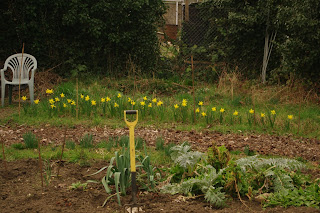A couple of good sessions on the allotment...
I finished mulching round the fruit bushes. My father had made a great suggestion to use the pine needles that drop copiously from a stately Scots Pine at the bottom of his garden; every year a thick new layer falls. I did some research and learned that pine mulching is common in the US (probably because they have a lot of pines!). Pine mulch may have the effect of making the soil slightly acidic over time- and fruit bushes like slightly acidic soil so it's all good.
Then I shoveled some well rotted kitchen compost round the bushes. The soil on the allotment seems rather depleted and will benefit from extra organic matter to improve the soil structure and fertility.
I then turned my attention to the two beds of where the raspberry canes are (or will be when they put on new growth). Having used the fresh needles on the fruit bushes I started to dig down into the spongey layers that have built up year after year beneath the pine tree. I would estimate each year adds about an inch and each layer becomes more crumbly until you reach loose friable soil five or six layers down where it begins to merge with the solid earth below.
It's a perfect mulching consistency and I now understand why the Americans refer to it as it pine straw mulch; it does indeed have the texture of composting straw. NB I mixed it with a bag of regular garden compost that was going spare to add a further fertility boost.
One potential drawback of mulching is that it can provide a happy home for slugs but I don't think they'll like pine mulch, we'll see.
All in all a job worth doing. And better still the cost in pounds, shillings and pence: zero. Carbon footprint: zero (I wheeled my wheel barrow down the streets broad and narrow, it's about a 10 minute walk from my father's to the allotment). Always very satisfying to garden on the basis that nothing is wasted.




